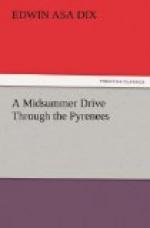At length, the light-house is neared, and to the right Bayonne is seen, not far off. The breack turns to the right along the river Adour, which here runs to the sea, and, skirting the long stone jetties, we roll toward town by the Allees Marines, a wide promenade along the river, cross the bridge, rattle through the streets, and draw up before the hotel in the open square with a jingle and whip-cracking and general hullaballoo which fills the street urchins with awe and gives unmixed joy to our jolly driver.
II.
Bayonne has been a centre.
A few cities are suns, the rest planets. This, with regard to their importance, not their size.
If Bordeaux is the sun of southwestern French commerce, Bayonne has at least been the most important planet, with the towns and villages of a wide district for its satellites.
Here we catch the first breath of the bracing mediaeval air we shall breathe in the Pyrenees. Bayonne has still a trace of the free, out-of-door spirit of its lawless prime. Miniature epics, more than one, have clustered around it. The rallying-cry, “Men of Bayonne!” has always appealed to the intensest local pride to be found perhaps in France, and the boast of the city still is that it has never been conquered. Looking back to the sharp times when every near warfare centred about Bayonne,—when feudal enmities were constantly outcropping on quick pretexts,—when the issue always gathered itself into hand-to-hand encounter, and was determined by personal prowess,—the boast is not meaningless.
The Basques, who are close neighbors to Bayonne, make the same boast. As Basques and Bayonnais were always fighting, their respective boasts seem to be continuing the conflict. But these old feuds, desperately bitter, were after all local and guerilla-like, and the advantages ephemeral. At few times did either people clash arms with the other in a general war. Thus neither conquered the other, and in peace their boasts joined hands against all comers.
III.
Bestriding both the river Nive and the swift Adour, Bayonne seems a healthy and healthful city, viewed in this June sunshine. But there is little of the new about it. The horses are taken from the breack, we leave at the hotel a requisition for lunch, and move forth for a survey. The chief streets are wide and airy, but a turn places one instantly in an older France. We ramble with curiosity in and out among the streets and shops, finding no one preeminent attraction, but an infinite number of minor ones which maintain the equation. In fact there is little for the guide-book sight-seer in Bayonne. The cathedral leaves only a dim impression of being in no wise remarkable. The citadel affords, it is said, a wide-ranging view, but we prefer the arcades and the people to the heat of the climb. The shops along the square are small but characteristic; they are evidently for the Bayonnais themselves rather than for strangers; this gives them their only charm for strangers. But taken in its entirety and not in single effects, the town is wholly pleasing. These dark, ancient arcades, its old houses, its rough-cobbled pavements, its general appearance of fustiness, give it a charmingly individual air.




